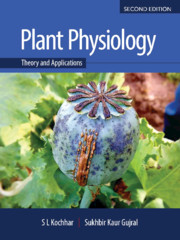Book contents
- Frontmatter
- Contents
- Foreword
- Preface to the Second Edition
- Preface to the First Edition
- Acknowledgements
- Some Common Abbreviations used in the Text
- Abbreviations for Units
- Unit I Water and Mineral Translocation in Plants
- Unit II Metabolism and Bioenergetics
- Unit III Growth and Development
- Unit IV Physiological Stress and Secondary Metabolites – Their Role in Metabolism
- Unit V Crop Physiology – An Innovative Approach
- Unit VI Breakthroughs in Plant Physiology
- Unit VII Some Experimental Exercises
- Glossary
- References
- Index
- Colour Plates
Chapter 23 - Experimental Exercises
Published online by Cambridge University Press: 12 May 2020
- Frontmatter
- Contents
- Foreword
- Preface to the Second Edition
- Preface to the First Edition
- Acknowledgements
- Some Common Abbreviations used in the Text
- Abbreviations for Units
- Unit I Water and Mineral Translocation in Plants
- Unit II Metabolism and Bioenergetics
- Unit III Growth and Development
- Unit IV Physiological Stress and Secondary Metabolites – Their Role in Metabolism
- Unit V Crop Physiology – An Innovative Approach
- Unit VI Breakthroughs in Plant Physiology
- Unit VII Some Experimental Exercises
- Glossary
- References
- Index
- Colour Plates
Summary
Plant–Water Relations
Experiment 1.1
To determine the osmotic potential of any given plant material by using the incipient plasmolytic method. Also, to determine the osmotic potential of an unknown solution.
Requirements
Plant material : The leaves of Tradescantia spathacea1/Commelina/Zebrina
Family : Commelinaceae
Chemicals : Sucrose solution (1 molal), distilled water, unknown sucrose solution
Glass apparatus : Petri dishes, glass slides, cover slips, beakers, pipettes (1 ml, 10 ml)
Miscellaneous : Microscope, forceps, needle, stop watch, graph paper
Principle
An actively metabolizing cell comprises of a permeable cell wall and semipermeable plasma membrane and tonoplast. The bulk of the space in a cell is occupied by the vacuole, which is a storehouse of minerals, osmotic substances like sugars, amino acids, organic acids and secondary metabolites like anthocyanin, and so on. Under normal, fully distended conditions, cells are said to be ‘turgid’. When such cells are shifted to a hypertonic solution, the movement of water occurs from a region of high water potential to a region of low water potential resulting in the loss of turgor. This is followed by shrinking of the cytoplasm away from the cell wall, i.e., Plasmolysis. The stage when there is initial pulling away of the cell membrane from the cell wall and the turgor pressure becomes zero, is known as ‘incipient plasmolysis’. Plasmolysed cells can be deplasmolysed by placing them in hypotonic solutions. In hypotonic solutions, turgor pressure develops, which presses the membrane against the cell wall. The rigid cell wall exerts an equal and opposite pressure termed as wall pressure and the cell is said to be turgid.
Water potential is the algebraic sum of three components:
Procedure
Prepare a series of sucrose solutions ranging from 0.15 to 0.35 m, using 1 m sucrose as stock solution (Dilution Table). Take out epidermal peels from the zone near central midrib portion of lower surface of the leaf by applying differential or unequal pressure. Place 3 peels in each petri dish after a time gap of 5 minutes. Wait for 10 minutes2 or so, mount the peels on the slides in their respective solutions and observe under microscope (6×, 40×).
- Type
- Chapter
- Information
- Plant PhysiologyTheory and Applications, pp. 663 - 822Publisher: Cambridge University PressPrint publication year: 2020



